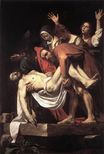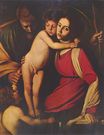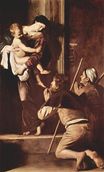Caravaggio - Entombment 1603
 |
 |
 |
 |
 |
 |
 |

Entombment 1603
300x203cm oil/canvas
Pinacoteca Vaticana, Vatican City
The image is only being used for informational and educational purposes
<< Previous G a l l e r y Next >>
From Wikipedia, the free encyclopedia:
This counter-reformation painting – with a diagonal cascade of mourners and cadaver-bearers descending to the limp, dead Christ and the bare stone – is not a moment of transfiguration, but of mourning. As the viewer's eye descends from the gloom there is, too, a descent from the hysteria of Mary of Clopas through subdued emotion to death as the final emotional silencing. Unlike the gored post-crucifixion Jesus in morbid Spanish displays, Italian Christs die generally bloodlessly, and slump in a geometrically challenging display. As if emphasizing the dead Christ's inability to feel pain, a hand enters the wound at his side. His body is one of a muscled, veined, thick-limbed laborer rather than the usual, bony-thin depiction.
Two men carry the body. John the Evangelist, identified only by his youthful appearance and red cloak supports the dead Christ on his right knee and with his right arm, inadvertently opening the wound. Nicodemus grasps the knees in his arms, with his feet planted at the edge of the slab. Caravaggio balances the stable, dignified position of the body and the unstable exertions of the bearers.